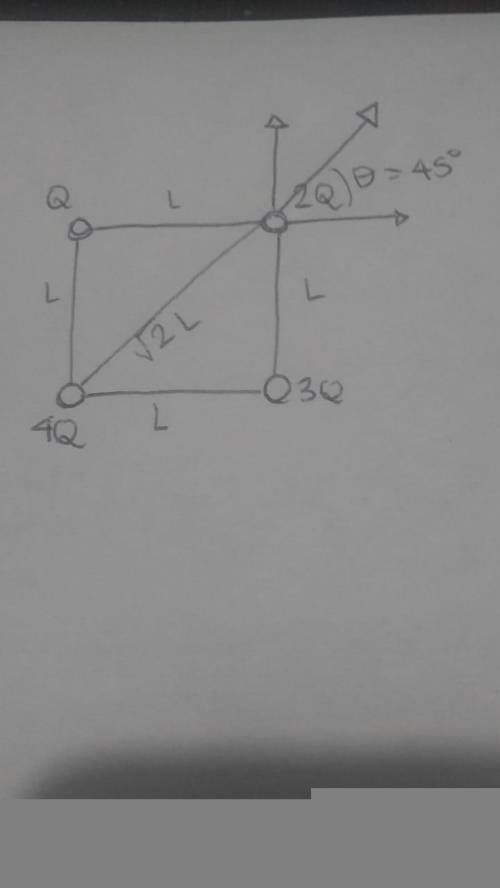
Physics, 28.05.2020 17:02 taylord4230
At each corner of a square of side l there are point charges of magnitude Q, 2Q, 3Q, and 4Q. What is the magnitude and direction of the force on the charge of 2Q?

Answers: 1
Another question on Physics

Physics, 22.06.2019 02:30
The particle in a two-dimensional well is a useful model for the motion of electrons around the indole ring (3), the conjugated cycle found in the side chain of tryptophan. we may regard indole as a rectangle with sides of length 280 pm and 450 pm, with 10 electrons in the conjugated p system. as in case study 9.1, we assume that in the ground state of the molecule each quantized level is occupied by two electrons. (a) calculate the energy of an electron in the highest occupied level. (b) calculate the frequency of radiation that can induce a transition between the highest occupied and lowest unoccupied levels. 9.27 electrons around the porphine ring (4), the conjugated macrocycle that forms the structural basis of the heme group and the chlorophylls. we may treat the group as a circular ring of radius 440 pm, with 20 electrons in the conjugated system moving along the perimeter of the ring. as in exercise 9.26, assume that in the ground state of the molecule quantized each level is occupied by two electrons. (a) calculate the energy and angular momentum of an electron in the highest occupied level. (b) calculate the frequency of radiation that can induce a transition between the highest occupied and lowest unoccupied levels.
Answers: 1

Physics, 22.06.2019 08:00
Tafari worked one summer on a ship that set weather buoys in the ocean. he watched how one of the buoys moved in the water. describe which parts of the wave would cause the buoy to bob up and down. which wave property determined how fast the buoys bobbed in the water? he observed that when the wind blew harder, the ocean waves were larger, and the buoys moved away from the ship. what effect, if any, did the waves have on how far the buoys moved? explain your answer.
Answers: 3

Physics, 22.06.2019 11:30
With the simplified model of the eye, what corrective lens (specified by focal length as measured in air) would be needed to enable a person underwater to focus an infinitely distant object? (be careful-the focal length of a lens underwater is not the same as in air! assume that the corrective lens has a refractive index of 1.62 and that the lens is used in eyeglasses, not goggles, so there is water on both sides of the lens. assume that the eyeglasses are 1.90
Answers: 1

Physics, 22.06.2019 12:30
Write a full page that sumerizes thermodynamics it’s from the website visionlearnig
Answers: 1
You know the right answer?
At each corner of a square of side l there are point charges of magnitude Q, 2Q, 3Q, and 4Q. What is...
Questions


Mathematics, 09.04.2021 21:20




Mathematics, 09.04.2021 21:20

Mathematics, 09.04.2021 21:20


English, 09.04.2021 21:20

English, 09.04.2021 21:20


Social Studies, 09.04.2021 21:20


Mathematics, 09.04.2021 21:20


Mathematics, 09.04.2021 21:20


Mathematics, 09.04.2021 21:20

Social Studies, 09.04.2021 21:20

World Languages, 09.04.2021 21:20

![F_T=6k\frac{Q^2}{L}\hat{i}+10k\frac{Q^2}{L}\hat{j}=2k\frac{Q^2}{L}[3\hat{i}+5\hat{j}]](/tpl/images/0668/7735/1cca9.png)


![F_T=F_Q+F_{3Q}+F_{4Q}\\\\F_T=k\frac{(Q)(2Q)}{R_1}\hat{i}+k\frac{(3Q)(2Q)}{R_2}\hat{j}+k\frac{(4Q)(2Q)}{R_3}[cos\theta \hat{i}+sin\theta \hat{j}]](/tpl/images/0668/7735/e8694.png)
![F_T=k\frac{2Q^2}{L}\hat{i}+k\frac{6Q^2}{L}\hat{j}+k\frac{8Q^2}{\sqrt{2}L}[cos(45\°)\hat{i}+sin(45\°)\hat{j}]\\\\F_T=k\frac{2Q^2}{L}\hat{i}+k\frac{6Q^2}{L}\hat{j}+k\frac{8Q^2}{\sqrt{2}L}[\frac{\sqrt{2}}{2}\hat{i}+\frac{\sqrt{2}}{2}\hat{j}]\\\\F_T=6k\frac{Q^2}{L}\hat{i}+10k\frac{Q^2}{L}\hat{j}=2k\frac{Q^2}{L}[3\hat{i}+5\hat{j}]](/tpl/images/0668/7735/c160b.png)




